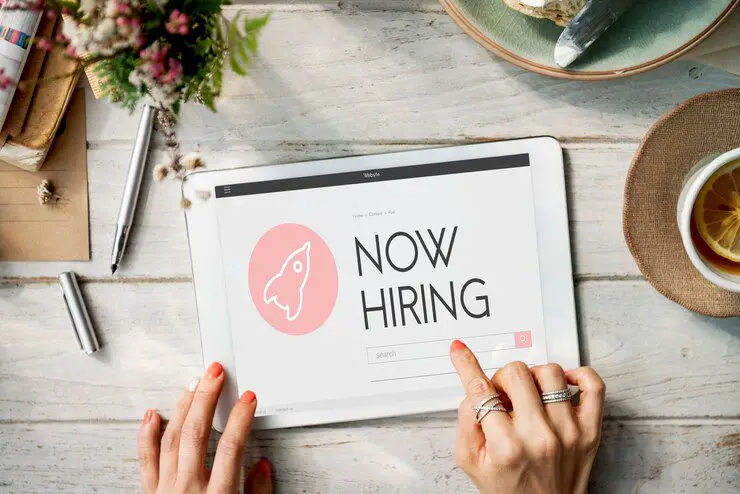Hey there, small business heroes! So, you’re thinking about how to hire your first employee? That’s awesome! It’s like adding a new superhero to your team! But finding the right person can be a bit tricky, like trying to find a matching sock in a laundry basket full of clothes!
But don’t worry, Startup Ninjas! Here at InsiderBlog.co.uk, we’re here to help you every step of the way. Think of us as your trusty guides, leading you through the exciting jungle of hiring your first employee!


This guide is like a treasure map, showing you exactly how to find the perfect person for your team. We’ll help you understand the rules, write an awesome job description, and even create a super welcoming workplace.
So, grab your explorer hat, and let’s dive into the adventure of hiring your first employee!
Hiring Hacks
- Be prepared! Before you start looking for someone, make sure you have enough money to pay them and that you know all the rules about hiring. It’s like making sure you have enough snacks and know the rules of the game before inviting a friend over to play!
- Write a clear job description! This is like creating a treasure map that tells people exactly what kind of treasure they’ll find (the job!) and how to get it!
- Look everywhere! Don’t just put your job listing in one place. Share it on job websites, social media, and tell all your friends! It’s like putting up “Lost Puppy” posters all over the neighborhood!
- Ask lots of questions! When you interview people, ask them about their skills and experience. It’s like trying to find the perfect puzzle piece that fits your team!
- Make a good offer! Don’t just offer money. Think about other cool things like health insurance and vacation time. It’s like offering your friend not just cookies but also milk and a fun game to play!
- Welcome your new employee! Make them feel happy and comfortable in their new job. It’s like throwing a welcome party for a new friend!
- Help them learn and grow! Give your employee chances to learn new things and get better at their job. It’s like helping them level up in their favorite video game!
- Follow the rules! Make sure you know all the laws about hiring and paying employees. It’s like knowing the rules of the road before you start driving!
- Don’t rush! Take your time to find the right person. It’s like choosing the perfect ice cream flavor – you want to make sure you love it!
- Build a strong team! Make sure your team works well together and has fun. It’s like building the coolest treehouse with your friends!
Importance of Hiring Your First Employee


Being a small business owner is exciting and scary when you think about hiring your first employee. It’s a big step. But, knowing when to grow your team can really help your business.
Signs It’s Time to Hire
Do you work too much? Is your business making more money? Are you missing chances because you’re too busy? Or is your customer service getting worse? If yes, it might be time to hire someone.
Getting the right person can make your business run better. They can bring new skills and help your business grow.
Benefits of Hiring an Employee
Having your first employee can really help your small business. It can make your business more productive. You’ll get new skills and be able to grow more.
Finding the right person is a big step for your business. It lets you do more and serve your customers better.
Preparation Before Hiring


Before you hire your first employee, make sure your business is ready. Look at your cash flow analysis to see if you can handle the payroll costs. This includes their salary, benefits, payroll taxes, and insurance. Talk to an accountant to check if you have the right business tax ID and know the laws.
Assessing Financial Readiness
Check your cash flow statement to see if you can afford another employee. Make sure your payroll costs don’t take up more than 30% of your income. This rule might change if your business needs a lot of workers.
Understanding Legal Requirements
When you hire your first employee, you’ll face many legal requirements. Learn about federal, state, and local employment laws. These cover things like wages, working hours, and what employees are entitled to.
You’ll also need to deal with payroll taxes. You’ll have to take out the right amount and send it to the government. Think about the employee benefits you’ll offer, like health insurance and retirement plans.
- Get the right business tax ID (EIN) to be seen as an employer
- Learn about federal, state, and local employment laws and rules
- Figure out the payroll taxes you’ll have to take out and pay, like federal income tax and Social Security
- Choose the employee benefits you’ll give, like health insurance and retirement plans
Defining the Role and Job Description
When you hire your first employee, it’s key to clearly define the role. You need a detailed job description. This helps attract the right candidates and sets clear expectations.
The job description should include the job title, a summary of the responsibilities, and the required skills. It should also tell about your business. Thinking about how the role can grow with your company is important.
To define the role and job description well, consider these key points:
- Identify the essential duties and responsibilities of the position. This should include a clear outline of the day-to-day tasks, as well as any long-term projects or goals the employee will be expected to contribute to.
- Determine the necessary skills, experience, and qualifications required for the role. This could include specific technical skills, industry knowledge, or soft skills like communication and problem-solving.
- Outline the job title and how it fits into your organizational structure. Consider how this position can support and complement your existing team and business objectives.
- Provide information about your company, its values, and the work environment. This can help attract candidates who align with your culture and vision.
- Think about the potential for growth and development within the role. Describe how the employee can contribute to your company’s long-term success and how the position may evolve over time.
By carefully defining the role and creating a detailed job description, you’ll find the right candidate. This candidate will support your small business’s growth and success.
Navigating the Hiring Process
Making a good job listing is key in hiring. Your job posting should have the job title and a detailed job description. It should also tell about your business and how to apply. Make sure to show the good things about the job to draw in the best people.
Creating an Effective Job Listing
When making a job listing, focus on the main tasks and what you need. Use a clear job title that shows what the job is. In the job description, list the daily tasks, skills, and experience needed.
Include any special needs, like certifications. Also, talk about the great things your company offers. This will attract more candidates.
Advertising and Sourcing Candidates
- Post the job listing on job boards and professional networks specific to your field.
- Use your social media to tell people about the job opening.
- Talk to your network of friends and work contacts for leads.
- Try sourcing tools like LinkedIn to find and talk to potential candidates.
By making a great job listing and using many ways to advertise, you can find many good candidates. This will help you find your first hire.
Conducting Interviews and Screening
Getting ready for interviews is key to finding the right person. Look over each candidate’s resume and cover letter. This helps you understand their background and skills.
You might also want to give them pre-interview tasks or tests. This shows their skills. Make a list of interview questions to check their skills and fit with your team.
Interview Preparation
Before the interviews, spend time reviewing each candidate’s info. Look closely at their resume and cover letter. This tells you about their experience, skills, and goals.
Also, think about giving them pre-interview tasks or tests. These tests show their real skills.
Candidate Evaluation Strategies
Use many ways to check each candidate. Do structured interviews with the same interview questions. This checks their skills and if they fit with your team.
Don’t forget to check references. This gives you info on their past work and reliability. You might also give them an aptitude test or a trial period. This lets you see how they work and if they’re a good fit.
How to Hire Your First Employee
Hiring your first employee is a big step for any small business. After finding the best candidate, it’s time to make a job offer. Think about more than just the salary. Consider benefits like health insurance, paid time off, and retirement plans too.
Before you offer the job, know the legal rules for hiring. You’ll need an Employer Identification Number (EIN) for tax purposes.
- Think about using blind recruitment to fight bias and boost diversity. Diverse teams do better by 35%.
- Get ready to withhold taxes and file the Federal Wage and Tax Statement (Form W-2). You’ll also need to handle state taxes.
- Keep employment tax records for six years. Store the Form I-9 and supporting documents for three years after hiring.
- Follow state rules, like joining the E-Verify program or getting workers’ compensation insurance.
Hiring your first employee is a big step for your small business. Offer a good compensation package and follow the law. This way, you can attract and keep the best talent to help your business grow.
Onboarding and Training New Hires


Welcoming new hires is key to their success in your business. Glassdoor says good onboarding can keep 82% of employees and make them 70% more productive. But, 32% of employees find onboarding confusing, and 22% think it’s disorganized.
Developing an Onboarding Plan
Make a detailed onboarding plan for your new employees. It should include:
- Compliance and safety training
- Processes and procedures
- Benefits and compensation
- Technical skills development
- Soft skills training
- Company culture and values
- Product and service training
- Technology, tools, and systems
The onboarding time can change based on the job and company. But, always offer support and resources. This helps new hires feel at home and excited about their job.
Investing in a good onboarding plan boosts onboarding new hires and employee integration. It also helps keep employees longer and improves your business. Companies with happy workers are 21% more productive and get better customer reviews.
Establishing a Positive Work Environment
When you hire your first employee, start with a positive work place. A friendly and welcoming culture makes your new hire feel important and happy. It also helps your small business do well.
Make sure your team talks openly. This lets everyone share their thoughts and feelings. Encourage your team to work together and come up with new ideas.
Make sure your company’s culture matches your values. This helps your new hire fit in and understand what your company is all about. Give your employees chances to help grow the company. This makes them feel like they’re part of something big.
A positive work place attracts and keeps great people. It also makes your team more engaged. Remember, your first hire helps set the tone for your company’s culture. So, make sure you get it right from the start.
Managing Employee Performance
As a small business owner, it’s key to manage your new employee’s performance well. This helps them grow and makes your company succeed. It’s important to set clear performance metrics and give regular feedback.
Setting Clear Expectations
Start by setting clear goals and expectations for your new employee. This helps them know what’s expected and how to improve. Regular checks on their progress and praise for their work can keep them motivated and happy.
Providing Feedback and Reviews
It’s vital to have a system for giving feedback and doing performance reviews often. Give constructive feedback that’s both positive and helpful. Work together to find solutions and plan for the future. Also, recognizing their hard work and achievements makes the workplace better.
Complying with Employment Laws
As a small business owner, hiring your first employee is a big step. You must know the laws at the federal, state, and local levels. This ensures you meet all the rules.
Wage laws are very important. You must follow minimum wage and overtime rules. You also need to handle payroll taxes and send them to the right places.
- Obtain an Employer Identification Number (EIN) for tax purposes
- Register with the state’s Employment Development Department (EDD) to obtain a state identification number
- Provide workers’ compensation insurance coverage for your employees
- Comply with the California Fair Employment and Housing Act (FEHA) to prevent discrimination and harassment
- Familiarize yourself with the Family Medical Leave Act (FMLA) and other leave policies
There’s more than just wages and taxes. You also need to think about benefits, safety, and keeping records. Keeping up with laws helps protect your business and employees.
Employee Benefits and Compensation
When you hire your first employee, it’s key to offer a good benefits package. This helps attract and keep the best workers. Think about health insurance, retirement plans, and paid time off.
Look at what others in your field offer. Talk to your accountant to make a package that works for your business and your new hire.
Offering Competitive Benefits
A strong benefits package can make your small business stand out. It can attract the best candidates. Here are some ideas:
- Health insurance: This is a big plus for your employees. It shows you care about their health.
- Retirement plans: Helping your employees save for the future is a great benefit.
- Paid time off: Giving days off for vacation, sick leave, and holidays helps balance work and life.
But remember, these benefits cost money. Make sure they fit your budget. A professional can help you make a package that’s good for your business and your employees.
Building a Strong Company Culture
Starting with a positive company culture makes new hires feel valued and motivated. Encourage teamwork and new ideas. Make sure your culture matches your business’s values and mission.
It’s important to keep your team happy and engaged. Give them time off to rest and recharge. An open-door policy helps everyone feel heard and less stressed.
Having a diverse team brings in different ideas. Use digital tools to keep everyone connected, even if they’re not in the same place. Keeping your team happy helps your business grow.
- Outline your company’s vision and ensure it aligns with potential team members.
- Identify tasks where help is needed most in the business to determine the first position to fill when hiring.
- Design the hiring process intentionally, considering the company’s vision and culture to find the ideal team member.
A strong company culture attracts and keeps great talent. This helps your small business succeed in the long run.
“The secret of my success is that we have gone to exceptional lengths to hire the best people in the world.” – Steve Jobs
Fostering Employee Retention
In today’s job market, keeping the best workers is key for your small business to grow. Good strategies to keep your top employees happy and engaged are crucial. They help your business grow and stay stable.
Strategies for Retaining Top Talent
To keep your best workers, try these ideas:
- Give good pay and benefits that match what others offer. This includes health insurance, retirement help, and vacation time.
- Help your employees grow by offering training and career chances. This means training, mentorship, and chances to move up in the company.
- Make sure your employees have a good work-life balance. Offer flexible hours, work from home options, and plenty of leave. This helps them handle work and life better.
- Always thank and reward your employees for their hard work. This can be bonuses, public thanks, or other ways to show you value them.
By focusing on keeping your employees, you build a strong, dedicated team. This team supports your business’s growth and success. Taking care of your team’s needs and helping them grow makes your company culture better and boosts productivity.
Common Hiring Mistakes to Avoid
As a small business owner, it’s key to steer clear of common mistakes. Rushing the hiring process is a big one. The U.S. Department of Labor says a bad hire can cost up to 30% of an employee’s salary each year.
Another mistake is ignoring unconscious bias. Interviewers should listen more than they talk. This helps avoid quick judgments. It’s also important to check references to see if candidates are truthful about their skills.
Many small businesses don’t have a clear plan for hiring. Having a solid hiring policy helps everyone involved. It makes sure the role is well-defined and the onboarding process is smooth. This way, you can make the best choices for your business and help new employees succeed.
What Happens Next?
Wow, Startup Ninjas, we’ve learned so much about how to hire your first employee! It’s like we’ve built a whole robot together, piece by piece!
Remember, finding the right person for your team is like finding a treasure. It takes time and effort, but it’s worth it in the end. And once you’ve found that perfect person, make sure to welcome them with open arms and help them learn and grow.
Here at InsiderBlog.co.uk, we’re always here to help you on your hiring journey. We want to see your small business succeed and your team grow stronger!
So, go out there and use your new hiring skills to find the perfect addition to your team! And don’t forget to share this guide with your friends who might be thinking about hiring too. Together, we can build a whole army of awesome small businesses!
Frequently Asked Questions (FAQ)
1. How do I know if I’m ready to hire my first employee?
It’s like knowing when you’re ready for a pet! You need to make sure you have enough time and money to take care of them. For your business, that means having enough money to pay your employee and enough work to keep them busy.
2. Where can I find good candidates for my first employee?
It’s like looking for a hidden treasure! You can look online on job websites, ask your friends and family, or even put up signs in your community.
3. What kind of questions should I ask during an interview?
It’s like getting to know a new friend! Ask about their hobbies, what they’re good at, and why they want to work with you.
4. How do I make a job offer that someone can’t refuse?
It’s like offering your friend the coolest toys to play with! Offer a good salary, fun benefits like vacation time, and a chance to learn and grow.
5. How do I make my new employee feel welcome?
It’s like throwing a party for a new friend! Show them around the office, introduce them to everyone, and make sure they have everything they need to do their job.
6. How do I help my employee learn and grow?
It’s like helping them level up in their favorite video game! Give them chances to learn new things, go to training sessions, and even try new tasks.
7. What are some common mistakes I should avoid when hiring?
It’s like trying not to step on the cracks in the sidewalk! Don’t rush the process, make sure you ask everyone the same questions, and always check their references.
8. How can I create a positive work environment for my new employee?
It’s like building a cozy fort where everyone feels safe and happy! Make sure everyone is friendly and helpful, and that everyone has a chance to share their ideas.
Hey Startup Ninjas, now that you’ve learned all about how to hire your first employee, it’s time to put on your hiring hat and find that perfect person for your team! Don’t forget to share this awesome guide with your friends on social media so they can learn the secrets too! Let’s make InsiderBlog.co.uk the coolest place for small businesses to learn about hiring!
Source
- Business.org. (n.d.). 10 steps to hiring your first employee in a small business. Business.org. https://www.business.org/hr/workforce-management/how-to-hire-your-first-employee/
- NerdWallet. (n.d.). Hiring your first employee? Here’s how to do it. NerdWallet. https://www.nerdwallet.com/article/small-business/hiring-first-employee
- Entrepreneur. (n.d.). How to know when to hire your first employee. Entrepreneur. https://www.entrepreneur.com/growing-a-business/how-to-know-when-its-time-to-hire-your-first-employee/251736
- SCORE. (n.d.). Is it time to hire your first employee? Here’s how to know. SCORE. https://www.score.org/resource/blog-post/it-time-hire-your-first-employee-here’s-how-know
- Patriot Software. (n.d.). How to hire your first employee: Ultimate checklist. Patriot Software. https://www.patriotsoftware.com/blog/payroll/hire-your-first-employee-ultimate-checklist/
- DigitalOcean. (2023). 11 tips for hiring your first employee in 2023. DigitalOcean. https://www.digitalocean.com/resources/articles/hiring-your-first-employee
- LegalZoom. (n.d.). How to hire your first employees. LegalZoom. https://www.legalzoom.com/articles/how-to-hire-your-first-employees
- Pursuit Lending. (n.d.). Small business tips: Hiring your first employee. Pursuit. https://pursuitlending.com/resources/hiring-your-first-employee/
- PGC Group. (n.d.). Steps to take to hire your first employee in the US. PGC Group. https://pgcgroup.com/blog/hire-your-first-employee-in-the-us
- Homebase. (n.d.). Hiring your first employee: What you need to know as a small business. Homebase. https://joinhomebase.com/blog/hiring-your-first-employee/
- PeopleKeep. (n.d.). Ten-step checklist for hiring your first employee for your small business. PeopleKeep. https://www.peoplekeep.com/blog/ten-step-checklist-for-hiring-your-first-employee
- Chase. (n.d.). How to hire your first employee. Chase. https://www.chase.com/business/knowledge-center/professional-development/how-to-hire-your-first-employee
- Next Insurance. (n.d.). How to hire your first employee: A step-by-step hiring checklist. Next Insurance. https://www.nextinsurance.com/blog/how-to-hire-your-first-employee/
- The Hartford. (n.d.). How to hire your first employees. The Hartford. https://www.thehartford.com/business-insurance/strategy/hiring-first-employee
- Square. (n.d.). How to hire employees: A checklist for employers. Square. https://squareup.com/us/en/the-bottom-line/growing-your-team/basic-labor-laws-how-to-hire-employees-correctly
- The Muse. (n.d.). 7 keys to hiring your start-up’s first employee. The Muse. https://www.themuse.com/advice/7-keys-to-hiring-your-startups-first-employee
- Harvard Business Review. (2023, July). A guide to onboarding new hires (for first-time managers). Harvard Business Review. https://hbr.org/2023/07/a-guide-to-onboarding-new-hires-for-first-time-managers
- Shareable. (n.d.). Employee onboarding guide: How to onboard new hires. Shareable. https://hires.shareable.com/blog/onboarding-new-employees
- Stripe. (n.d.). How to hire the first employees for your startup. Stripe. https://stripe.com/resources/more/how-to-hire-the-first-employees-for-your-startup-a-guide-for-founders
- Bespoke HR. (n.d.). How to hire your first employee. Bespoke HR. https://www.bespokehr.com/how-to-hire-your-first-employee/
- Forbes. (2019, January 22). Five things to do before hiring your first employee. Forbes. https://www.forbes.com/sites/forbescoachescouncil/2019/01/22/five-things-to-do-before-hiring-your-first-employee/
- HoneyBook. (n.d.). How to hire employees and manage a team: Guide for business owners. HoneyBook. https://www.honeybook.com/blog/hire-employees-and-manage
- IceHrm. (n.d.). How to hire your first employee: 5 easy-to-follow steps. IceHrm. https://icehrm.com/blog/how-to-hire-your-first-employee-5-easy-to-follow-steps/
- California Department of Industrial Relations. (n.d.). Before the first employee starts work. Department of Industrial Relations. https://www.dir.ca.gov/dlse/BeforeAnEmployeeStarts.html
- Lawpath. (n.d.). Ultimate legal guide to hiring an employee in California: Key steps. Lawpath. https://lawpath.com/blog/hiring-employees-california
- The Hartford. (n.d.). Legal requirements for hiring employees at your small business. The Hartford. https://sba.thehartford.com/managing-employees/hiring/hiring-laws/
- Gusto. (n.d.). Framework: Hiring your first employee crash course [PDF]. https://go.gusto.com/rs/110-WOX-868/images/Framework_Hiring_Your_First_Employee_Crash_Course.pdf
- LumApps. (n.d.). 10 steps to build a successful company culture. LumApps. https://www.lumapps.com/employee-experience/how-to-build-company-culture/
- Business News Daily. (n.d.). How to hire an employee for cultural fit. Business News Daily. https://www.businessnewsdaily.com/6866-hiring-for-company-culture.html
- Whitney English. (n.d.). Ready to build your team? Here’s how to hire your first employee. Whitney English. https://blog.whitneyenglish.com/ready-build-team-heres-hire-first-employee/
- Forbes. (2024). 15 effective employee retention strategies in 2024. Forbes. https://www.forbes.com/advisor/business/employee-retention-strategies/
- PeopleAK. (n.d.). The five steps to fostering employee retention. PeopleAK. https://peopleak.com/five-steps-to-fostering-employee-retention/
- CareerPlug. (n.d.). Employee retention strategies: How to keep your top talent engaged. CareerPlug. https://www.careerplug.com/blog/employee-retention/
- Trakstar. (n.d.). 7 common hiring mistakes (and how to avoid them). Trakstar. https://hire.trakstar.com/blog/7-common-hiring-mistakes-and-how-to-avoid-them
- Business News Daily. (n.d.). How to avoid common hiring mistakes. Business News Daily. https://www.businessnewsdaily.com/5827-employer-hiring-mistakes.html
Was this helpful?
Yay! 🎉 You made it to the end of the article!


















